Semi-aquatic turtles refer to turtles that spend significant time in and out of water. Many of the freshwater turtles of the world are semi-aquatic. Turtles such as sliders, cooters, wood turtles, map turtles, and several others spend a significant amount of time out of water (basking) each day.
They can also be found on land often. However, these chelonians also live in water. This duality makes them semi-aquatic turtles. Even box turtles are considered semi-aquatic although they prefer to spend most of their time on land.
If you wish to keep semi-aquatic turtles as pets, you need to consider setting up an aquatic enclosure for the turtle(s).
Table of Contents
Types Of Semi Aquatic Turtles
1. Spotted Turtles

- Experience Level: Intermediate
- Family: Emydidae
- Scientific Name: Clemmys guttata
- Average Adult Size: 4 inches
- Lifespan: 25 – 30 years
- Average Price Range: $80 to $300
- Recommended Books: The Spotted Turtle: North America’s Best by Al Roach
Spotted turtles are small semi-aquatic turtles endemic to Canada as well as the Eastern United States. These turtles are easily distinguishable by the many yellow spots all over their carapace. The hardy nation of this turtle makes it one of the easiest chelonians to care for.
Due to their endangered nature, Clemmys guttata is quite difficult to find. Captive-bred specimens are also quite costly to acquire.
2. Chicken Turtle
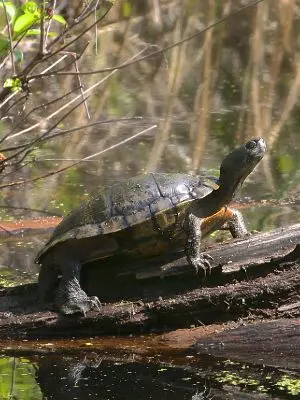
- Experience Level: Advanced
- Family: Emydidae
- Scientific Name: Deirochelys reticularia
- Average Adult Size: 6 to 10 inches
- Lifespan: 24 years
- Average Price Range: $150
- Where to buy: Snakesatsunset.com or Theturtlesource.com
The chicken turtle derives its common name from its taste. Apparently, this turtle tastes like chicken. While D. reticularia used to be common and popular, these days, wild specimens are quite rare.
This turtle looks very much like the eastern painted turtle. However, unlike the eastern painted turtle, D. reticularia has a long neck, which is almost as long as its carapace.
The limbs and neck of this turtle are covered in yellow stripes. Males have longer tails and claws than females do but females are overall bigger.
Chicken turtles can be found both on land and in water. They sometimes also burrow into soil.
D. reticularia are quite uncommon on the captive-bred pet market.
3. Bog Turtle

- Family: Emydidae
- Scientific Name: Glyptemys muhlenbergii
- Average Adult Size: 3.1 to 4.5 inches
- Lifespan: 40 years
Glyptemys muhlenbergii is a critically endangered turtle and as such captive-bred specimens are almost impossible to come by and when they do appear, their cost is usually in the thousands.
This turtle has a dark carapace with yellow blotches on its neck. Even the plastron is darkly colored, so are the limbs and head. The G. muhlenbergii is a small turtle and generally reaches lengths of jut 4 inches.
G. muhlenbergii can be found in the eastern United States. Since they are critically endangered, they are generally found in small separate colonies.
4. North American Wood Turtle
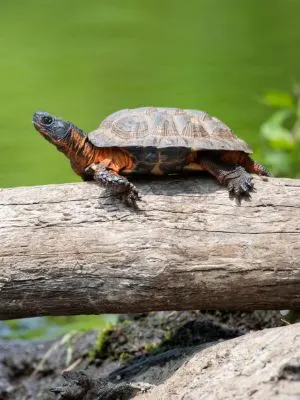
- Experience Level: Intermediate
- Family: Emydidae
- Scientific Name: Glyptemys insculpta
- Other Names: Wood turtle
- Average Adult Size: 6to 10 inches
- Lifespan: — years
- Average Price Range: $300
- Recommended Books: Wood Turtles: A Pet Care Guide for Wood Turtles by Lolly Brown
The wood turtle is an endangered turtle species endemic to North America. They are very friendly and tame turtles. This behavior makes them a fun turtle to raise. The wood turtle has closely related to the bog turtle. In fact, the bog and wood turtles are the only species in the genus Glyptemys.
Wood turtles live in swamps, marshes, and bogs. They are omnivorois and feed both in water and out of water. They eat vegetation, berries, seeds, and small invertebrates such as snails, insects , and worms.
5. Black Wood Turtle
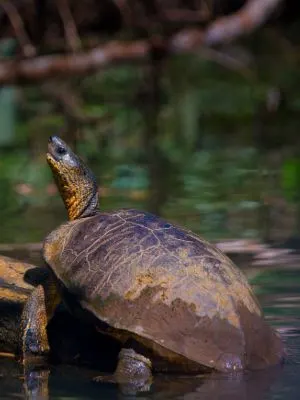
- Experience Level: Intermediate
- Family: Geoemydidae
- Scientific Name: Rhinoclemmys funerea
- Other Names: Black river turtle
- Average Adult Size: 12 inches
- Lifespan: 20 years
- Average Price Range: $65 to $200
- Where to buy: Undergroundreptiles.com or theturtlesource.com
- Recommended Books: Wood Turtles: A Pet Care Guide for Wood Turtles by Lolly Brown
This big turtle is endemic to Central America – namely Panama, Nicaragua, Honduras, and Costa Rica. Like other wood turtles, Rhinoclemmys funerea live near water bodies and can be found in swamps, marshes, rivers, and even ponds.
In terms of size, R. funerea are known to reach lengths of 14 inches. When housing a pet black wood turtle, it’s advisable to pirovide it a dry surface to walk on as well as a large container (such bowl) of water. The water should be deep enough for the reptile to submerge.
As the species is tropical, they require a warm and humid enclosure. If your locale is warm and humid enough, they can be kept in an outdoor enclosure.
6. Red-Eared Slider

- Experience Level: Intermediate
- Family: Emydidae
- Scientific Name: Trachemys scripta elegans
- Other Names: red-eared slider turtle, water slider turtle, red-eared terrapin, and red-eared turtle
- Average Adult Size: 7 inches
- Lifespan: 40 years
- Average Price Range: $10 to $40
- Recommended Books: Red-Eared Sliders (Animal Planet Pet Care Library) by Katrina Smith
Red-eared sliders are among the most popular pet turtle species. These are easy to care for and hardy. This hardiness can be an issue since they thrive in most ecosystems. Not only do they thrive, but also they may also negatively affect native species.
Trachemys scripta elegans has red streaks on both sides of its head. This gives them their common name. The friendly and resilient red-eared slider is actually endemic to the Mississippi River and its environs as well as the environs of the Gulf of Mexico.
Because Trachemys scripta elegans is an invasive species, pet red-eared sliders must never be released into the wild.
7. Southern Painted Turtle
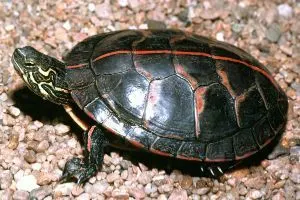
- Experience Level: Beginner
- Family: Emydidae
- Scientific Name: Chrysemys picta dorsalis
- Other Names: Common map turtle
- Average Adult Size: 4 to 6 inches
- Lifespan: 30 to 40 years
- Average Price Range: $15 to $50
- Where to buy: Backwaterreptiles.com
- Recommended Books: Aquatic Turtles: Sliders, Cooters, Painted, and Map Turtles by R.D. Bartlett and Patricia Bartlett
The southern painted turtle is so-called as this species is endemic to the southern United States – Missouri and Illinois to Louisiana. This chelonian is a subspecies of the painted turtle. This is the smallest painted turtle subspecies.
The Chrysemys picta dorsalis has a solid red line that runs down its dark carapace. The plastron is also tan. The limbs, neck, and head of this subspecies feature vivid yellow and red markings which appear to be painted on.
The semi-aquatic C. p. dorsalis can be found living close to swamps, marshes, ponds, lakes, and rivers. They can also be found basking on partially submerged logs on water bodies. Overall this species prefers slow-moving waters.
8. Eastern Painted Turtle
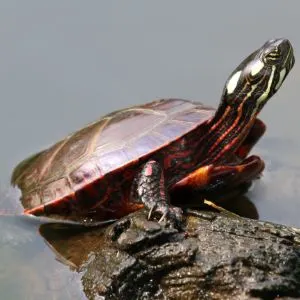
- Experience Level: Beginner
- Family: Emydidae
- Scientific Name: Chrysemys picta picta
- Other Names:
- Average Adult Size: 5 to 7 inches
- Lifespan: 30 to 40 years
- Average Price Range: $70 to $200
- Recommended Books: Aquatic Turtles: Sliders, Cooters, Painted, and Map Turtles by R.D. Bartlett and Patricia Bartlett
The eastern painted turtle is one of the more popilar turtles kept as pets. It is very similar in appearance to other painted turtles. While not the smallest, the Chrysemys picta picta is still a tiny turtle. This makes it easy to keep and care for.
The carapace of this turtle is dark (blackish to olive green). Prominent red and yellow maeking can be around the edge of the shell as well as on the limbs. The plastron of this chelonian is usually plain yellow.
9. Florida Red-Belly Turtle
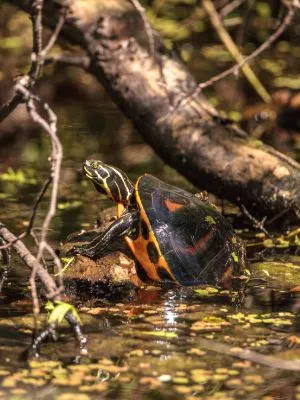
- Experience Level: Beginner
- Family: Emydidae
- Scientific Name: Pseudemys nelsoni
- Other Names: Florida red-bellied cooter
- Average Adult Size: 5 to 7 inches
- Lifespan: 33 years
- Average Price Range: $50 to $100
- Where to buy: Theturtlesource.com or Backwaterreptiles.com
- Recommended Books: Aquatic Turtles: Sliders, Cooters, Painted, and Map Turtles by R.D. Bartlett and Patricia Bartlett
The florida redbelly is an american turtle endemic to southern georgia and florida. This mostly herbivorois turtle is quite popular among turtle enthasiasts. This is because of their cute appearance and hardy nature.
As you may have already guessed, the P. nelsoni has a red tinged plastron. The carapace is brownish with a red Y-shape pattern. The females are generally larger than the males’ are, although the males have thicker tails and longer front claws.
10. Eastern Box Turtle
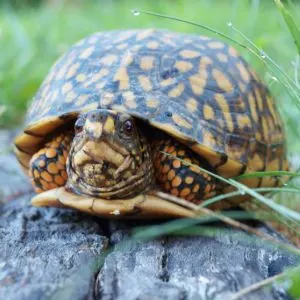
- Experience Level: Beginner
- Family: Emydidae
- Scientific Name: Terrapene carolina carolina
- Other Names: Common box turtle
- Average Adult Size: 4 to 7 inches
- Lifespan: 40 years
- Average Price Range: $200 to $400
- Recommended Books: Box Turtles (Complete Herp Care) by Tess Cook
While largely terrestrial, the box turtle is still a pond turtle and as such is a semi-aquatic turtle. This turtle needs a dry enclosure with a large bowl of water to hydrate in. In addition, this turtle needs a humid enclosure to be healthy.
T. c. carolina is mostly endemic to eastern United States. This chelonian is blackish or brownish with bright orange patterns ove its limbs and head.
11. Map Turtles

- Experience Level: Beginner
- Family: Emydidae
- Scientific Name: Graptemys
- Other Names: Sawback
- Average Adult Size: 3.5 to 10 inches (males are generally significantly smaller)
- Lifespan: 15 to 100 years
- Average Price Range: $5 to $50
- Recommended Books: Aquatic Turtles: Sliders, Cooters, Painted, and Map Turtles by R.D. Bartlett and Patricia Bartlett
Map turtles are among one of the most popular semi-aquatic turtles kept as pets. There are over 15 species that belong to the genus Graptemys, which contain all the map turtles.
Map turtles are so-called because of the contour-like patterns on the carapace. We will have a look at two of the most popular species in the genus Graptemys.
12. False Map Turtle
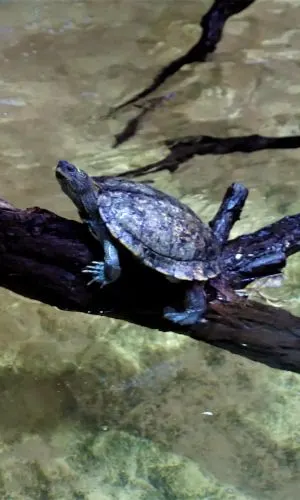
- Experience Level: Beginner
- Family: Emydidae
- Scientific Name: Graptemys pseudogeographica
- Other Names: Mississippi map turtle (G. p. kohnii), False map turtle (G. p. pseudogeographica)
- Average Adult Size: 3.5 to 10 inches
- Lifespan: 30 to 50 years
- Average Price Range: $5 to $50
- Where to buy: Backwaterreptiles.com or turtlestore.com
- Recommended Books: Aquatic Turtles: Sliders, Cooters, Painted, and Map Turtles by R.D. Bartlett and Patricia Bartlett
False map turtles are a common pet species. There are two subspecies within this species namely: the nominotypical subspecies (false map) and the Mississippi map. These turtles are easy to care for but require an aquatic setup. As they are semi-aquatic, you need to provide a dry surface where they can bask and rest.
As with the other map turtles, this species has contour patterns on their carapace. The species also has a brownish carapace.
13. Northern Map Turtle

- Experience Level: Beginner
- Family: Emydidae
- Scientific Name: Graptemys geographica
- Other Names: common map turtle
- Average Adult Size: 4 to 10 inches
- Lifespan: 30 to 50 years
- Average Price Range: $60 to $200
- Where to buy: Freshmarine.com or theturtlesource.com
- Recommended Books: Aquatic Turtles: Sliders, Cooters, Painted, and Map Turtles by R.D. Bartlett and Patricia Bartlett
These turtles are also known as common map turtles as they are widespread. They are likely the most common of all the map turtles. These turtles are comparable to false map turtles. Interestingly, unlike false map turtles, these turtles are generally not kept as pets. This is because they are notoriously difficult to breed. Graptemys geographica can be found from Quebec and Ontario to Alabama. They are endemic to the eastern part of North America.
Graptemys geographica is brownish with yellow contour-like patterns.
Conclusion
Semi-aquatic turtles are among the most common of turtles. These species are also popular with turtle enthusiasts all around the world. Species such as map turtles, cooters, sliders, and box turtles are commonly kept as pets.
So what are semi-aquatic turtles? These are turtles that spend a significant amount of time both in water and out of water as opposed to aquatic turtles that spend almost all their time underwater. In the wild, semi-aquatic turtles generally spend a large portion of their day basking out of water on partially submerged logs and vegetation.
These turtles usually hunt and forage underwater and sleep underwater but can also be found on land usually close to a water body.
